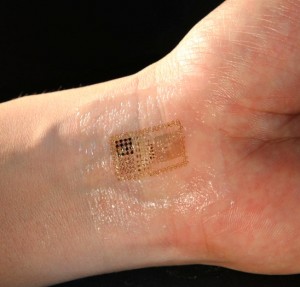 Are William Gibson’s visions close to becoming a real-world QS fantasy? Or a privacy debacle?
Are William Gibson’s visions close to becoming a real-world QS fantasy? Or a privacy debacle?
An “epidermal electronic system” (EES) is a thin film with electronic circuits that mounts on your skin, designed to stretch, flex, and twist — and to take input from the movements, electrical currents, and other measurable signals from your body. Research coming out this week in Science from labs in Illinois and San Diego proposes that this technology has arrived.
Of course there are a lot of questions raised by this photo: Where’s the power source? How is the data transmitted off-chip? It’s likely that we’re a long way off from a seamless product.
But this technology (even if it’s years away from reality) raises the possibility of ubiquitous low-power sensors and actuators mounted to human bodies, measuring the various available signals and applying electric and magnetic fields to modify our physiologic states.
The applications proposed by its inventors are appealing: measuring sleep, heart rate, brain waves and such, all in the name of “advancing human health.” It’s the holy grail of ubiquitious passive sensors that enable effortless quantification of your biometrics, state of mind and health. Amazing.
But the article doesn’t mention the dozens of truly devious applications that immediately ran through my head. If individuals apply this technology to themselves, it could be extremely useful. But if it’s easy to apply to people without their knowledge or control…
Here’s a link to a more in-depth article: Article from io9 (http://io9 NULL.com/5830071/breakthrough-electronic-circuits-that-are-integrated-into-your-skin)
And a link to the abstract in Science (http://www NULL.sciencemag NULL.org/content/333/6044/838 NULL.abstract)

